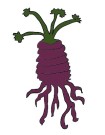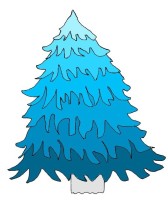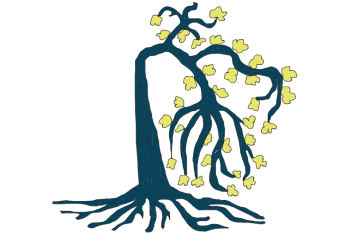You don’t have to live in a castle to have a gargoyle as a pet. In fact, many […]
Fantasy
Jellyglops are small, fist-sized creatures that look like glops of jelly. They dwell on the floor, sides, and […]
Flyways are underground highways for birds. These tunnels run for thousands of miles and are particularly useful when […]
Doac’s Walking Stick can be found leaning against a tree or boulder in the forest No. Finding the […]
Marby Theodoren is the most noted genius of the twelfth age. He discovered how to molecularly dissect ghosts, and transform their genetic makeup into something tangible. He became one of the wealthiest figures after marketing his so-called “canned ghosts” to the public. They are now the fastest growing industry. After his death, he canned himself, and is available for rent. He resides next to a number of other famous canned ghosts in the Xalilio Palace Gift Shop.
Toranada used to sit on the Eastern edge of the Forest No, between the sea and the forest. […]
The Gargoyle Security Company has been established since the fourth age and is well known throughout the land for providing excellent protection in the form of monsters.
The Dexterous Whale is so smart that it once grew legs by sheer will.
Illigen Icicles are commonly used in snowy regions as spies by military officials. These icicles form when water […]
Climbing Corals are ambitious marine invertebrates, and are often seen scaling underwater mountains while reciting solemn elegies. Upon […]
Solponds are created when rays of sunshine fall from the sky and into small bodies of water. These […]
People have been driven mad trying to figure out what might be inside it, and there are scholars who devote their entire lives to studying the mysterious box.
Dissamo aquagons are a type of water dragon that peruse empty expanses of the sea. They are able […]
The time traveling cycloposaurus travels to the past, present, and future in a circus tent. The origins of […]
Glowecans originate from fire snap marshes and can actually glow in the dark. Born from the fiery flames, […]
 Rahas are underwater sea vegetables that bud in waves and travel with currents. While they have roots, rahas only use them as propellers. Found exclusively in southern regions, they prefer to stay near the surface of the sea to soak up sunlight. Often their green stalks will poke into the air like shark’s fins. Many species feast on rahas, including various porpoises, fish, and crustaceans. The purple body and green stalks are so full of nutrients and have such a sweet taste that even carnivorous creatures will eat them. Humans collect rahas when they wash on shore and will also go to great means to fish them out the the sea.
Rahas are underwater sea vegetables that bud in waves and travel with currents. While they have roots, rahas only use them as propellers. Found exclusively in southern regions, they prefer to stay near the surface of the sea to soak up sunlight. Often their green stalks will poke into the air like shark’s fins. Many species feast on rahas, including various porpoises, fish, and crustaceans. The purple body and green stalks are so full of nutrients and have such a sweet taste that even carnivorous creatures will eat them. Humans collect rahas when they wash on shore and will also go to great means to fish them out the the sea.
 It is said that bugocolors were created when Belonoira, the rainbow goddess, fell from the sky and shattered into millions of tiny pieces. The shards of rainbow fell into the sea, and were given life by the Dexterous Whale. Now, when rainbows are present in the sky, small bugocolors scurry across the giant, curved prisms. Sometimes there are so many insects on one rainbow that it looks like a colorful, undulating wave in the sky. Little is known about the bug, and many questions have remained unanswered. Scientists yearn to know where bugocolors live when they aren’t on rainbows, and more importantly, how they find the beginning of a rainbow.
It is said that bugocolors were created when Belonoira, the rainbow goddess, fell from the sky and shattered into millions of tiny pieces. The shards of rainbow fell into the sea, and were given life by the Dexterous Whale. Now, when rainbows are present in the sky, small bugocolors scurry across the giant, curved prisms. Sometimes there are so many insects on one rainbow that it looks like a colorful, undulating wave in the sky. Little is known about the bug, and many questions have remained unanswered. Scientists yearn to know where bugocolors live when they aren’t on rainbows, and more importantly, how they find the beginning of a rainbow.
Honeycomb turtles are found only on the Ikue Chain Islands in the West Sea. The islands are the […]
Poyees are the only known creatures to share characteristics with ducks, porcupines, and slugs. Having no legs, they […]
The hydrolyzed fin has been traipsing for thousands of years, and seems to be invincible.
Intergalactic storm clouds are harmless 99.99% of the time, however, there is a .01% chance that a sneeze from one will produce a lightning bolt that triggers spontaneous transmogrification.
The cloud reservoir is made up of a clear dome twenty miles in circumference. Inside are hundreds of […]
The Flamaranthine has been spotted several times deep in the forest No, usually kindled on top of an abandoned campfire.
The oafish is considered an unseemly fish because of its repugnant appearance. It lives in freshwater streams and […]
For as long as anyone could remember rabbits had been coming out of the mountain. It begins at […]
The empalare is one of the many extinct prehistoric trees. Common carnivorous trees today evolved from these trees […]
Guelve pine trees are mobile trees that like to dig holes. They push off from the ground with their […]
Scientists are unsure how to classify noconutt trees because they look identical to common coconut trees, however, the coconuts on […]
Reidolon trees are technically brown, but appear blood red. The bark oozes a crimson syrup that is poisonous […]
There are some trees that deserve pages and pages entirely for themselves. The Aurelian is such a tree…
 The coberyl pine tree is best known for its presence in the story, Sa’ Kleiness. In the story, the unicorn named Sa, replaces her broken horn with a pinecone from a coberyl tree. Once fixed to the unicorn’s head, the pinecone turns from basic brown to beautiful, white, and glittering. Afterwards, Sa touches the coberyl tree with her new horn, and all of the pinecones on the tree transform, too. According to the story, Sa’s tree still stands deep in the mountain forest. Rather common, the coberyl tree is seen peppered along mountain sides and in forests. It is a hardy and non-mobile tree that has a rainbow of pine needles in different hues of blue. It grows only in wintry regions, and needs a combination of snow and ice to affix the tree’s shallow roots to the ground.
The coberyl pine tree is best known for its presence in the story, Sa’ Kleiness. In the story, the unicorn named Sa, replaces her broken horn with a pinecone from a coberyl tree. Once fixed to the unicorn’s head, the pinecone turns from basic brown to beautiful, white, and glittering. Afterwards, Sa touches the coberyl tree with her new horn, and all of the pinecones on the tree transform, too. According to the story, Sa’s tree still stands deep in the mountain forest. Rather common, the coberyl tree is seen peppered along mountain sides and in forests. It is a hardy and non-mobile tree that has a rainbow of pine needles in different hues of blue. It grows only in wintry regions, and needs a combination of snow and ice to affix the tree’s shallow roots to the ground.
Many artists are drawn to the querrilogue tree because of its mysterious and moody mannerisms, but also because it […]
The dualdae tree has two bristling branches protruding from the main trunk. These branches are often compared to […]
 The jumbotant tree has an extensive root system, making it the perfect mobile tree. Despite its mass, the tree can move quickly and quietly through the forest. It is a popular home to the elusive six-toed monkey. Rarely seen out of the tree, they live their entire lives in its balloon-like leaves. The monkeys are masters at getting the tree to travel at will. The jumbotant tree is more common in the Southern regions, as that is where the monkeys prefer to live, however, sometimes you will see an entire tree filled with babbling monkeys traveling elsewhere. The jumbotant tree has a lengthy life, documented living well over five-hundred years. On many instances, the same monkey family line is as old as the tree itself.
The jumbotant tree has an extensive root system, making it the perfect mobile tree. Despite its mass, the tree can move quickly and quietly through the forest. It is a popular home to the elusive six-toed monkey. Rarely seen out of the tree, they live their entire lives in its balloon-like leaves. The monkeys are masters at getting the tree to travel at will. The jumbotant tree is more common in the Southern regions, as that is where the monkeys prefer to live, however, sometimes you will see an entire tree filled with babbling monkeys traveling elsewhere. The jumbotant tree has a lengthy life, documented living well over five-hundred years. On many instances, the same monkey family line is as old as the tree itself.
The flummox tree actually begins life as a small ox worm. After a year, it cocoons itself into […]
No one knows what a pure engrove tree looks like. These trees can take nearly any shape once the seeds are altered. Artists […]
 The weeping woolley tree buds petite tufts of woolley flowers. After picked and processed, the tufts make luxurious fiber that is highly sought after. Weeping woolleys are mobile trees, which makes them impossible to farm. They tend to be shy and seek solitude deep in the forest. They do not liked to be picked, and the flowers can stay on for years before falling off. Some trees have so many woolley flowers on them that they look like giant, puffy clouds. The trunk is dark teal in color, and the flowers are a butter yellow. Because of the woolley warmth, many animals occupy the tree, especially in winter. The flowers provide heat and comfort against the cold. Many lost explorers have been saved by taking refuge inside a weeping woolley on a cold night.
The weeping woolley tree buds petite tufts of woolley flowers. After picked and processed, the tufts make luxurious fiber that is highly sought after. Weeping woolleys are mobile trees, which makes them impossible to farm. They tend to be shy and seek solitude deep in the forest. They do not liked to be picked, and the flowers can stay on for years before falling off. Some trees have so many woolley flowers on them that they look like giant, puffy clouds. The trunk is dark teal in color, and the flowers are a butter yellow. Because of the woolley warmth, many animals occupy the tree, especially in winter. The flowers provide heat and comfort against the cold. Many lost explorers have been saved by taking refuge inside a weeping woolley on a cold night.
Ophidiary trees are sometimes called “opposite trees” because of the reversal in color norm between the bark and […]
The Wombatty tree has bright leaves of green and magenta that attach to the tree by invisible stems. […]
There is a saying that goes, “You might have a home, but you haven’t lived in one until […]
The celestrapod is a migratory sea tree. It is thought that this species is a cross between a sugarbush […]
The Cogitare is the most dangerous tree in all the forest. It looks like an ordinary roanoak tree, […]
The blue plumule is bare year round, with the exception of one day in April in which it […]
The roots of threnodian trees are identical to their branches and it is almost impossible to distinguish between […]
